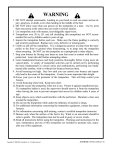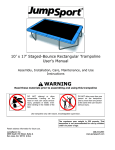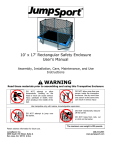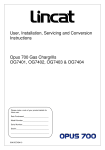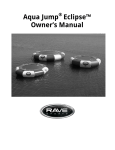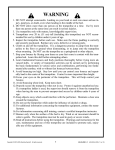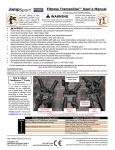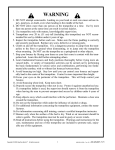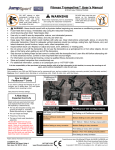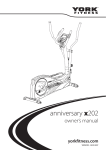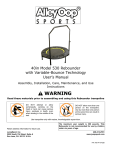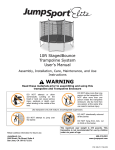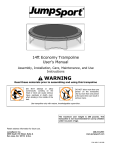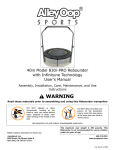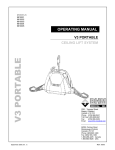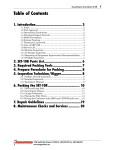Download JumpSport 14` Staged-Bounce Trampoline User`s Manual
Transcript
WARNING 1. DO NOT attempt somersaults. Landing on your head or neck can cause serious injury, paralysis, or death, even when landing in the middle of the bed. 2. DO NOT allow more than one person on the trampoline at a time. Use by more than one person at the same time can result in serious injuries. 3. Use trampoline only with mature, knowledgeable supervision. 4. Trampolines over 20 in. (51 cm) tall (including this trampoline) are NOT recommended for use by children under 6 years of age. 5. Inspect the trampoline before each use. Make sure the frame padding is correctly and securely positioned. Replace any worn, defective or missing parts. 6. Climb on and off the trampoline. It is a dangerous practice to jump from the trampoline to the floor or ground when dismounting, or to jump onto the trampoline when mounting. Do NOT use the trampoline as a springboard to other objects. 7. Stop your bounce by flexing your knees as your feet come in contact with the trampoline bed. Learn this skill before attempting others. 8. Learn fundamental bounces and body positions thoroughly before trying more advanced skills. A variety of trampoline activities can be carried out by performing the basic fundamentals in various series and combinations, performing one fundamental after another, with or without feet bounces between them. 9. Avoid bouncing too high. Stay low until you can control your bounce and repeatedly land in the center of the trampoline. Control is more important than height. 10. Focus your eyes on the perimeter of the trampoline. This will help control your bounce. 11. Avoid bouncing when tired. Keep turns short. 12. Properly secure the trampoline when not in use. Protect it against unauthorized use. If a trampoline ladder is used, the supervisor should remove it from the trampoline when leaving the area to prevent unsupervised access by children under 6 years of age. 13. Keep objects away which could interfere with the performer. Maintain a clear area around the trampoline. 14. Do not use the trampoline while under the influence of alcohol or drugs. 15. For additional information concerning the trampoline equipment, contact the manufacturer. 16. For information concerning skill training, contact a certified trampoline instructor. 17. Bounce only when the surface of the bed is dry. Wind or air movement should be calm to gentle. The trampoline must not be used in gusty or severe winds. 18. Read all instructions before using the trampoline. Warnings and instructions for the care, maintenance and use of this trampoline are included to promote safe, enjoyable use of this equipment. Copyright © 2002-2005 JumpSport, Inc. All rights reserved. JCTR M1440 (TR-INS-J-0312 rev 11) ATTENTION It is the responsibility of the purchaser to become familiar with all of the information in this booklet, to convey the warnings to all users, and to enforce the manufacturers rules for safe use. This unit is not intended for commercial or public use; and is therefore, strictly prohibited. Trampolines, being rebounding devices, propel the performer to unaccustomed heights and into a variety of body movements. Therefore, it is emphasized that all purchasers, and all persons using the trampoline, become familiar with the rules for safe use. Misuse and abuse of this trampoline is dangerous, and can cause serious injuries. The purchaser/user of this piece of equipment is assuming a degree of risk for which the manufacturer cannot be responsible. On the following pages are articles of information relative to the proper installation and safe operation of the trampoline. This information is a system of: Warnings and Cautionary Statements Homeowner Inspection, Care and Maintenance Trampoline Placement and Assembly Instructions Points of Safety Basic Skills and Instructional Materials Warranty, Repair, and Returns Procedures Read this information thoroughly before allowing the trampoline to be used. Keep this manual available for your review, and for review by all potential users. If there are questions please telephone the manufacturer for further explanation. The phone number is 1-408-213-2551, hours are 8:00am – 5:00pm Monday through Friday, Pacific Time. JumpSport, Inc. P.O. Box 2446 Saratoga, CA 95070 1-408-213-2551 Copyright © 2002-2005 JumpSport, Inc. All rights reserved. JCTR M1440 (TR-INS-J-0312 rev 11) Staged-Bounce™ Trampoline 14 Foot Model 1440 Featuring the Sure-Lok™ frame system ...and Staged-Bounce™ Technology. US Patent No. 6,840,891 and Patents Pending Assembly, Installation, Care, Maintenance, and Use Instructions WARNING Do not attempt or allow somersaults. Landing on your head or neck can cause serious injury, paralysis or death, even when landing in the middle of the bed. U S E R ‘ S M A N U A L Do not allow more than one person on the trampoline at a time. Use by more than one person at the same time increases the chance of injury. Read these materials prior to assembling and using this trampoline. Maximum user weight: 235 pounds Copyright © 2002-2005 JumpSport, Inc. All rights reserved. -1- JCTR M1440 (TR-INS-J-0312 rev 11) CAUTIONARY STATEMENT JumpSport® Trampolines are designed exclusively for the home backyard market. The vast majority of users of our trampolines are children, and therefore need close supervision and rules to follow while playing on the trampoline. These rules must be enforced by whomever is responsible for the care of the children. It is strongly recommended that the buyer of this product go over the rules and recommendations in the packet of information supplied, including those in this manual. It is also strongly recommended that these rules and recommendations be supplemented with those of your own (e.g., the time that jumping is allowed, when neighbors can visit, etc., and that these rules and recommendations be reviewed with anyone who is going to jump on the trampoline). If it is possible, these rules should be reviewed with the parents or guardians of any visitors who may be jumping on the trampoline. (See page 13 for Points of Safety). Recommended weight limitation is no more than 235 lbs. Persons at, or near this weight should test the resiliency of the springs prior to extensive bouncing. Do this by jumping lightly on the mat. If the resiliency appears to be weak (bed does not lift the individual when light jumps are made), discontinue bouncing immediately, take off the springs and inspect them. If the springs appear to be stretched out of shape, the mat should not be put back on until the springs have been replaced. Be sure to check the mat for any areas that need restitching, or “V” rings that may need replacing. Due to the risks associated with users falling off of trampolines, we strongly urge you to use a JumpSport® Safety Enclosure in conjunction with your trampoline. Please call JumpSport if you have any questions about such a device. We also urge you to not keep any ladder, step stool, or other climbing device next to the trampoline when use of the trampoline is not supervised by an adult. This precaution helps to prevent access to the trampoline by individuals that are too small, and/or do not have the physical strength necessary to jump on a trampoline without having the proper supervision. Copyright © 2002-2005 JumpSport, Inc. All rights reserved. -2- JCTR M1440 (TR-INS-J-0312 rev 11) Table of Contents The JumpSport® Safety Enclosure………………………………………………………………………4 Assembly: Trampoline Placement……………………………………………………………………………………..5 Assembly Instructions…………………………………………………………………………………...6-9 Care & Maintenance: Homeowner: Inspection, Protection, Maintenance Procedures, and Repairs....………………......10 Care and Maintenance………………………………………………………………………………….. 11 Care and Maintenance Check List……………………………………………………………………... 12 User Instructions: Points of Safety - Warnings…………………………………………………………………………….. 13 Basic Trampoline Skills Bouncing………………………………………………………………………………………….. 14 Arm Action………………………………………………………………………………………… 14 Bounce Variations……………………………………………………………………………….. 14 Basic Landing Positions Seat Drop…………………………………………………………………………………………. 15 Hands and Knees Drop………………………………………………………………………… 15 Front Drop……………………………………………………………………………………...15-16 Beginning Twisting………………………………………………………………………………. 16 Seat Drop, Half Twist, Seat Drop (Swivel Hips)……………...………………………………. 16 Front Drop, Half Twist, Front Drop (Turn Table)……………………………………………….16 Seat Drop, Full Twist to Seat Drop (Barrel Roll)……………………………………………….17 Additional Twisting………………………………………………………………………………..17 Warranty Information…………………………………………………………………………….Last Page Copyright © 2002-2005 JumpSport, Inc. All rights reserved. -3- JCTR M1440 (TR-INS-J-0312 rev 11) Safety Enclosure Congratulations on purchasing a JumpSport® trampoline! We sincerely believe that you have purchased the finest round trampoline on the market. It has been engineered with safety, durability, and performance in mind. As a result, this product features our StagedBounce™ mat system. Studies show that many of the injuries associated with trampoline use in a residential setting are a result of the user falling off of the trampoline and hitting the ground or some other object. For this reason, it is strongly recommended that a JumpSport® Safety Enclosure be used in conjunction with your trampoline. The JumpSport safety enclosure should be used as a supplement to mature, knowledgeable supervision – not a substitute. The JumpSport enclosure can also be locked to prevent unauthorized use. Please contact your local JumpSport dealer to learn more about the safety enclosure, or call JumpSport directly. Protect your trampoline with a Safety Enclosure U.S. Patent #6053845, 6261207 and Patents Pending Safe use of a trampoline also requires adequate knowledge of technique, as well as what not to do. Please read this manual thoroughly for key points of safety. Copyright © 2002-2005 JumpSport, Inc. All rights reserved. -4- JCTR M1440 (TR-INS-J-0312 rev 11) TRAMPOLINE PLACEMENT Adequate overhead clearance is essential. A minimum of 24 feet (7.3 meters) is recommended from ground level. Provide clearance for wires, tree limbs, and other possible hazards. Lateral clearance is essential. Place the trampoline away from walls, structures, fences, pools, and other play areas. Maintain a clear space on all sides of the trampoline. Place the trampoline on a level surface before use. Use the trampoline in a well-lighted area. Artificial illumination may be required for indoor or shady areas. Secure the trampoline against unauthorized and unsupervised use. Remove any obstructions from beneath the trampoline. The owner and supervisors of the trampoline are responsible to make all users aware of practices specified in the User Instructions section of the manual. Copyright © 2002-2005 JumpSport, Inc. All rights reserved. -5- JCTR M1440 (TR-INS-J-0312 rev 11) ASSEMBLY INSTRUCTIONS Read through all assembly steps carefully before beginning the assembly process. Refer to drawings for clarification. Assembly requires use of one 1/2“ and one 9/16“ wrench (or adjustable wrenches). Safety Glasses and Gloves are recommended during the assembly procedure. Top View STEP 1: Lay out all frame sections in a circle as shown (see Figure 1). Verify inventory of each part. Trampoline inventory consists of these components: 1) Top rail with left leg socket [TR-RAI-J-0320R1] – 4 pieces 2) Top rail with right leg socket [TR-RAI-J-0322R1] – 4 pieces 3) Top rail with no leg socket [TR-RAI-J-0321] – 4 pieces 4) Left vertical leg piece [TR-LEG-KJ-0717] – 4 pieces 5) Right vertical leg piece [TR-LEG-KJ-0718] – 4 pieces 6) Horizontal leg piece [TR-LEG-J-0057] – 4 pieces 7) Nuts [TR-NUT-J-0052] and Bolts [TR-BOL-J0051] – 8 sets 8) Springs [TR-SPR-X-0067] -96 pieces (boxed separately) 9) Jumping Mat/Bed [TR-MAT-J-0342] – 1 piece 10) Frame Pad half [TR-PAD-J-0714] – 2 pieces 11) Short elastic cords to join pad sections [TR-BUNX-0290] – 6 pieces 12) Long elastic cords [TR-BUN-J-0566] – 8 pieces 13) Warning Placard [TR-WRN-J-0136] – 1 piece 1 4 2 1 2 3 4 5 5 6 3 PARTS Top rail with left leg socket Top rail with right leg socket Top rail with no socket Vertical leg piece Horizontal leg piece FIGURE 1 If you are missing any parts, call 1-408-213-2551. Note: All top rail pieces have one smaller end. The smaller end should be facing the same direction (clockwise) for all parts when laid out correctly. Important: The components must be laid out in the pattern shown for the trampoline to be assembled correctly. STEP 2: Assemble all top rail pieces of the trampoline to form a ring For maximum fit and performance, all rail pieces include the Sure-Lok™ frame system. Assembly consists of aligning the “key way” on the small end of one section into the “key” on the larger end of the adjacent section (see Figure 2). Key Way Note: When joining the last two sections of the ring, it may be helpful to have someone stand on the opposite side of the ring while the assembler pushes inwards on the frame and joins the two. Copyright © 2002-2005 JumpSport, Inc. All rights reserved. Key FIGURE 2 -6- JCTR M1440 (TR-INS-J-0312 rev 11) STEP 3: Snap buttons (hidden from view here) at top must be facing the same direction Build each leg assembly A left vertical leg piece is “L-shaped” when the snap button at the top is facing away from view, and a right vertical leg piece will be “J-shaped.” Join one left, right, and horizontal leg piece to make a leg assembly (see Figure 3). Make sure that the buttons at the top of each leg are facing the same direction. Join the assembly tubes by installing bolt and nut at each joint. Tighten with wrenches but do not over-tighten. Repeat with the remaining leg pieces. Build leg assembly, insert bolt and nut at each joint, then tighten with wrenches Left leg Right leg Leg assembly STEP 4: Lift frame (ring) and install leg assemblies At this point, you may need someone to assist you with the assembly. Before performing this step, orient teach leg assembly so that the snap buttons at the top of each end face in towards the center of the trampoline (if applicable). As one person lifts one side of the trampoline ring, another should lift a leg assembly to a vertical position and insert one end into a socket on the ring (see Figure 4). With one end installed, install the other end of the leg assembly into the appropriate leg socket. For ease of assembly, the first end should be about 1/2 inch into the socket when installing second end. Snap legs into place (if applicable). FIGURE 3 Note: Each leg assembly should have a top rail piece with no leg sockets in the middle of its two vertical leg pieces (see Figure 4). Bolt heads of the leg assemblies should be facing the outside of the trampoline. Repeat installation of leg assembly on the opposite side of the trampoline, then at the two remaining locations. 1 Top rail with no leg socket in middle of each leg assembly 2 FIGURE 4 STEP 5: Hints Before Installing Springs Since you have purchased the Staged-Bounce™ trampoline, you will note that one half of the connection points on the mat have a small “V” rings, and one half have large “V” rings. This combination results in a more forgiving bed at initial impact, because the springs provide less resistance at that time. It may be helpful in the following steps to note that springs are most readily stretched into place with the aid of another spring. To do so, hook the spring you want to install to a “V” ring on the bed. Use another spring as a tool by connecting the second spring to the free end of this spring. Holding the second spring with one hand, pull the spring being installed toward the frame. When the spring being installed reaches the frame, hook it into the hole on the frame, and unhook the second spring (see Figure 5). Copyright © 2002-2005 JumpSport, Inc. All rights reserved. V-rings alternate between large and smaller sizes FIGURE 5 -7- JCTR M1440 (TR-INS-J-0312 rev 11) STEP 6: Install springs at every 4th hole and V ring Lay the jumping mat (bed) inside the frame with the warning labels facing up. Springs (boxed separately) are used to support the mat (bed) and are connected between “V” rings on the mat and holes in the top frame rail. Select a hole on the frame near one leg, and connect a spring between the V ring and the frame hole at this point. Count 4 holes on the frame (and 4 V rings) to the left (clockwise), and connect another spring. See step 5 for easier spring assembly. (Between spring one and two, there will be 3 empty holes and V rings.) Follow this procedure all the way around the trampoline (at 24 locations in total – see Figure 6). Be sure to count holes and V rings accurately. If the count is off, go to where the correct pattern was stopped, and begin again. Install a spring at every fourth hole and V ring FIGURE 6 STEP 7: Install springs to the middle hole of every section Between each of the 24 springs, there will be three empty holes and V rings. Working clockwise all the way around the trampoline, connect a spring at every middle V ring to the appropriate hole (see Figure 7). Newly installed springs shown in black STEP 8: Complete installation of the mat Install the remaining springs clockwise to complete the installation of the bed. FIGURE 7 Copyright © 2002-2005 JumpSport, Inc. All rights reserved. -8- JCTR M1440 (TR-INS-J-0312 rev 11) STEP 9: Layout, align, and join frame pad pieces Lay pad pieces over frame. Align notches in skirt with sockets at each leg. Plastic connectors should be on the underside of mat. Join pieces of pad using short elastic cords (three at each joint). Do not use the connectors closest to the outside edge of the pad for this step (see Figure 9). Do NOT tie the pads tightly together, or the pads may tear. STEP 10: Attach pad to frame of trampoline There will be two plastic anchors on the underside of the pad near each leg of the trampoline. Connect pad to leg by feeding long elastic cords through both connectors and then tying around each leg (Figure 10). Do NOT tie the pads tightly around the legs, or they may tear. Connect sections of skirt at joints also with long elastic cords. Cut ends if necessary to remove excess. Again, do NOT tie the pads tightly, or they may tear. FIGURE 8 View from underside of Pad IMPORTANT: Make sure that the pad is installed properly over the frame and the springs before use. STEP 11: 4th set of connectors (closest to edge of pad) are used to attach to trampoline leg with long bungees Attach warning placard to trampoline Attach the safety instruction placard using the enclosed cable (zip) tie. Place placard at the point where you will normally mount the trampoline so that it is visible, and attach to top rail with cable tie. FIGURE 9 Caution: For increased user protection, we strongly recommend installing a JumpSport safety enclosure to your trampoline. Contact JumpSport if you have any questions. FIGURE 10 ASSEMBLY IS NOW COMPLETE Make sure that all parts are securely assembled. Familiarize yourself and all users of the trampoline with the care and maintenance instructions, use and instructional materials, and safety precautions contained in this manual before using the trampoline. Caution: Use of this trampoline is NOT recommended without the frame pad properly installed, which is designed to reduce the likelihood of injury to the user from coming into contact with the frame and springs of the trampoline. If you do not have a frame pad, contact JumpSport to obtain a frame pad. Properly install the frame pad before using the trampoline. DISASSEMBLY To disassemble, follow the assembly steps in reverse order. Do not attempt to disassemble any frame components before the mat (bed) and springs have been removed. Copyright © 2002-2005 JumpSport, Inc. All rights reserved. -9- JCTR M1440 (TR-INS-J-0312 rev 11) HOMEOWNER: INSPECTION, PROTECTION, AND MAINTENANCE PROCEDURES All trampolines require maintenance at some time. Springs may need to be replaced, frame parts may become bent, stitching in the mat and safety pads may rot out. Inspect the trampoline before each use and replace any worn, defective, or missing parts. The following conditions could represent potential safety hazards: 1. Missing, improperly positioned or insecurely attached frame padding 2. Punctures, frays, tears or holes worn in the bed or frame padding 3. Deterioration in the stitching or fabric of the bed or frame padding 4. Over-stretched springs 5. A bent or broken frame 6. A sagging bed (black mat) 7. Sharp protrusions on the frame or suspension system An item that poses one of the greatest hazards is worn out or rotten stitching around the jumping mat (the black bed). STITCHING MAY FAIL WITHIN 2 TO 3 YEARS OR EARLIER, DUE TO EXCESSIVE USE OR EXPOSURE TO EXTREME WEATHER. In most cases where deterioration has begun, evidence will make itself known in the form of broken stitches at the straps or as rotting, frayed straps at the position of the v-ring. When this is found, all bouncing must cease and the trampoline immediately disassembled. The jumping mat should be replaced with the appropriate JumpSport® mat. Remember, the only thing between the jumper and the ground is the mat. If a deteriorated mat is not inspected properly, jumping can cause the mat to pull away from the straps in a large area so that the jumper may land on the ground. This could cause a serious injury. This trampoline is designed for year-round outdoor use. However, in climates of cold weather where snow and ice is prevalent, we recommend the mat be taken off and stored in a dry area. To remove the mat, simply reverse the assembly instructions for installing it. (See page 9-10). During an ice or snow storm, you should use extreme care in removing the ice and snow in order to remove the mat. We suggest using a high pressure water hose and spray upward from the underside of the trampoline starting at the mat’s lowest point. Another recommendation is to use hot water on the ice and snow to melt it away such that the mat can be removed. Left unattended in snow and ice, your trampoline jumping mat will accumulate weight in the middle causing damage to your springs. This type of damage is not covered by your warranty. In removing the snow and ice be sure to not use any type of sharp object such as a shovel, hoe, or garden rake to remove the ice as this may cause damage to your mat. This type of damage is not covered by your warranty. INSPECT YOUR TRAMPOLINE BEFORE EACH USE. If any materials are found defective, worn, or missing then jumping should be prohibited until the trampoline is repaired. If any warning labels or signs become unreadable or missing, call JumpSport for free replacements. REPLACEMENT PARTS All replacements parts should be ordered through JumpSport. Shoe shops, awning and tent companies, or upholsterers do not have the proper materials, equipment and methods for proper, safe repair of trampoline mats and safety pads. Call JumpSport® for a Return Authorization number for proper replacements 1-408-213-2551. Trampoline beds should be replaced in total should any tear or hole be greater than 1 inch in length or diameter. Patches over larger holes will eventually fail creating a potential for hazardous injuries. DO NOT REPAIR MATS WITH HOLES GREATER THAN 1 INCH. Copyright © 2002-2005 JumpSport, Inc. All rights reserved. -10- JCTR M1440 (TR-INS-J-0312 rev 11) CARE AND MAINTENANCE CARE Do not allow family pets on the trampoline, as claws may snag and pull the mat (bed) material or damage the frame pad. The trampoline is intended to be used by one person at a time, weighing less than 235 pounds. The user should be either barefoot, or wearing gymnastic slippers or non-cleated athletic shoes. The user should remove all sharp objects from their person which may cause injury or damage to the trampoline mat (bed). Heavy, sharp or pointed hard objects should not contact the mat (bed) surface. MAINTENANCE Your trampoline is manufactured using quality materials and is finely-crafted to provide you and your family with many years of enjoyment and exercise. Proper maintenance and care will help to prolong the life of the trampoline and reduce the possibility of injury. The following guidelines should always be observed. Inspect the trampoline before each use and replace any worn, defective or missing parts. The following conditions present potential hazards and increase the danger of personal injury. a. b. c. d. e. f. g. Missing, improperly positioned, or insecurely attached frame padding Punctures, frays, tears, or holes worn in the bed or frame padding Deterioration in the stitching or fabric of the bed or frame padding Over-stretched springs A bent or broken frame Sagging jumping mat (bed) Sharp protrusions on the frame or suspension system IF ANY OF THESE CONDITIONS EXIST, THE TRAMPOLINE SHOULD BE DISASSEMBLED OR OTHERWISE PROTECTED AGAINST USE UNTIL THE CONDITION IS REMEDIED. SPECIAL CONSIDERATIONS WIND It is possible for the trampoline to be blown about by a high wind. If you anticipate high winds, the trampoline should be moved to a sheltered location, disassembled, or the top of the frame should be secured to the ground with the use of a trampoline anchor kit. The anchor kit can be found at www.jumpsport.com Use a JumpSport® trampoline anchor kit to tie down the trampoline. Make sure the ends of the stakes are protected and the ropes are visible to users. MOVING THE TRAMPOLINE If you need to move your trampoline periodically, it should be moved by at least two people, kept horizontal and lifted slightly to move. Disassemble the trampoline for any other type movement. Copyright © 2002-2005 JumpSport, Inc. All rights reserved. -11- JCTR M1440 (TR-INS-J-0312 rev 11) CARE & MAINTENANCE SAFETY CHECK LIST IMPORTANT: Inspect the trampoline before using and replace any worn, defective, or missing parts. FRAME PADS: Our pad reduces the risk of accidental injury due to falling onto the frame railing and gives minimal resistance to striking or falling onto and through the springs. Frame pad life expectancy is one to two years. To increase life of pad: 1) Do not allow jumpers to stand or sit on pad; 2) Do not allow jumpers to grab pad in order to pull themselves onto trampoline; 3) Do not allow sharp, abrasive objects to come in contact with the pad surface. Safety Check Safe Unsafe Check for: Necessary Action Vinyl Deterioration Replace ______ ______ Foam Deterioration Replace ______ ______ Missing Pads Replace ______ ______ Improperly Attached Pads Reattach – See Pad Instructions ______ ______ Stitching Deterioration Re-stitch ______ ______ BEDS – (Black Mat):Beds require periodic re-stitching maintenance every 2 to 3 years. Normal bed life is 5 to 8 years with two re-stitchings. Make certain the trampoline is visually inspected by a responsible adult, checking the stitching carefully at each “V-ring“ before every use. See page 5 for further information on this critical subject. Check for: Necessary Action Safe Unsafe Bent or missing V-rings Replace V-rings ______ ______ Faded & breaking top thread Regular re-sew ______ ______ Brittle & tearing V-ring tabs Complete re-sew ______ ______ Cuts, tears, or holes on bed Patch* ______ ______ (Holes greater than 1” cannot be repaired) Missing Warning Labels SPRINGS: FRAME: Phone manufacturer for replacement ______ ______ The life of a set of springs is 2 to 5 years depending on weight of jumpers, frequency of use, and care. Check for: Necessary Action Safe Unsafe Over-stretched springs Replace ______ ______ Missing springs Replace ______ ______ Weak (soft) springs Replace ______ ______ The life of your JumpCourt Trampoline frame should last 5 to 10 years, depending upon the weather in the area where you live. Check for: Necessary Action Safe Unsafe Rust Clean & paint ______ ______ Structural failure Replace ______ ______ Bent frame Repair or replace part ______ ______ Sharp protrusions Repair ______ ______ Missing frame warning labels Phone manufacturer for replacement ______ ______ SAFETY RULES – Review this manual with all jumpers. Maintain all warning labels and signs. If labels or signs become lost or unreadable write or telephone the manufacturer for free replacements. Copyright © 2002-2005 JumpSport, Inc. All rights reserved. -12- JCTR M1440 (TR-INS-J-0312 rev 11) POINTS OF SAFETY– WARNINGS It is essential that trampoline users follow a carefully planned safety program so that the trampoline can be fully enjoyed. Most accidents can be classified into the following headings: 6. Climb on and off the trampoline. It is dangerous to jump onto the trampoline when mounting. Do NOT use the trampoline as a springboard to other objects. LANDING ON SPRINGS OR FRAME The risk of falling on, landing between the springs, or hitting the frame, can be reduced through: proper mounting and dismounting of the trampoline; emphasizing jumping at the center of the bed without traveling toward the sides; and by the installing quality frame pads. Simple frame pads or spring covers on their own, do not give adequate protection. Installing a JumpCourt® Safety Enclosure, or using spotters will greatly reduce the risks of injury mentioned above. 7. Stop your bounce by flexing your knees as your feet come in contact with the trampoline bed. Learn this skill before attempting others. BOUNCING OFF THE TRAMPOLINE This problem can be controlled, if not completely eliminated, through proper instruction and mastering of “STOP BOUNCE,” maintaining a position in center of bed, strictly forbidding any “FLYING DISMOUNT,” installing a JumpCourt Safety Enclosure, or using spotters. Keep other objects away from the trampoline. It is a dangerous practice to jump from the trampoline to the floor or ground. Do not jump from the trampoline into a swimming pool, a swing, or any other object. Do not install trampoline on concrete, asphalt or hard compacted surfaces. LANDING INCORRECTLY ON THE BED Landing incorrectly on the bed creates great risk of a serious injury with most of these resulting from attempting somersaults. IT IS STRONGLY RECOMMENDED THAT SOMERSAULT PROCEDURES NOT BE PRACTICED. Serious injury or death may occur. READ THE FOLLOWING PRECAUTIONS 1. Do NOT attempt somersaults. Landing on your head or neck can cause serious injury, paralysis, or death, even when landing in the middle of the bed. 2. Do NOT allow more than one person on the trampoline at a time. Use by more than one person at the same time can result in serious injuries. 3. Use trampoline only with mature, knowledgeable supervision. 4. Trampolines over 20 in. (51 cm) tall (including this trampoline) are NOT recommended for use by children under 6 years of age. 5. Inspect the trampoline before each use. Make sure the frame padding is correctly and securely positioned. Replace any worn, defective or missing parts. Copyright © 2002-2005 JumpSport, Inc. All rights reserved. 8. Learn fundamental bounces and body positions thoroughly before trying more advanced skills. A variety of trampoline activities can be carried out by performing the basic fundamentals in various series and combinations, performing one fundamental after another, with or without feet bounces between them. 9. Avoid bouncing too high. Stay low until you can control your bounce and repeatedly land in the center of the trampoline. Control is more important than height. 10. Focus your eyes on the perimeter of the trampoline. This will help control your bounce. 11. Avoid bouncing when tired. Keep turns short. 12. Properly secure the trampoline when not in use. Protect it against unauthorized use. If a trampoline ladder is used, the supervisor should remove it from the trampoline when leaving the area to prevent unsupervised access by children under 6 years of age. 13. Keep objects away which could interfere with the performer. Maintain a clear area around the trampoline. 14. Do not use the trampoline while under the influence of alcohol or drugs. 15. For additional information concerning trampoline, contact the manufacturer. the 16. For information concerning skill training, contact a certified trampoline instructor. 17. Bounce only when the surface of the bed is dry. Wind or air movement should be calm to gentle. The trampoline must not be used in gusty or severe winds. 18. Read all instructions before using the trampoline. Warning and instructions for the care, maintenance and use of this trampoline are included to promote safe, enjoyable use of this equipment. -13- JCTR M1440 (TR-INS-J-0312 rev 11) BASIC SKILLS BOUNCING BOUNCE VARIATIONS The most important thing about bouncing is that it should be done with control in the center of the bed. The basic bounce should always begin low. High, reckless bouncing should never be allowed. The following figures show three variations, which should be assumed at the top of the bounce, before resuming the normal landing position on the feet. The Stop Bounce This technique allows the jumper to gain control by stopping quickly. It is done by keeping the feet in contact with the bed, and absorbing the rebound of the trampoline with the knees and waist. This skill should be learned right away and should be employed whenever you feel out of balance, or land away from the center area. Tuck To learn the stop bounce: (1) Stand in center of the bed with your feet about hipwidth apart. (2) Attempt about three easy bounces, keep them low and controlled. (3) Focus your eyes towards the perimeter of the trampoline while bouncing in order to keep your balance. Pike (4) Stop the bounce by bending at your knees and hips on contact with the bed. ARM ACTION Arms are very important for proper control and lift. Whenever you go up, your arms go up. They go up to a set position about shoulder height and shoulder width. They should remain in this balanced position until you start down. Then they circle down and slightly behind the hips, ready to lift again as you bounce up. Straddle Pike Practice these simple variations and concentrate on perfect form. Make sure that the toes are pointed and fingers are straight. Also make sure that you are taking off and landing in the same spot on the center of the bed. These simple variations to the basic bounce can be a lot of fun, and are very important for gaining experience in coordinated movement. Copyright © 2002-2005 JumpSport, Inc. All rights reserved. -14- JCTR M1440 (TR-INS-J-0312 rev 11) BASIC LANDING POSITIONS Positions for all drops (seat, hands and knees, front, and back) should first be performed on the ground, then in a stationary position on the trampoline bed. Once the position is correctly executed, the drop can be performed after “priming” the trampoline bed. Priming is done by bending the knees and pushing down repeatedly on the trampoline bed, thereby setting the bed in motion. The feet stay in contact with the bed during the entire priming motion. The Seat Drop (1) From the standing position, prime the bed several times. feet. The Front Drop (2) Pick up your feet at the top of the last bounce, and sit Contact with the trampoline bed should simultanedown. You should land so that your body is in a sitting ously take place with your hands, elbows, chest, stomach, position with your legs straight out in front of you and and hips. Knees should be bent. your toes pointed. Hands should be on the bed next to your hips. Fingers should be together and pointed toHands should be placed close together with palms in ward the toes. contact with the bed forming a triangle. Eyes should be (3) Push on the bed with your hands to rebound up to your focus on triangle or slightly in front of your fingers. STEP 1: (1) Start from the hands and knees drop position. (2) As you rebound from the hands and knees, stretch so that you land on your stomach. From this position, rebound to your hands and knees. STEP 2: (1) Start from a standing position with knees bent so that your upper body is low and close to the trampoline bed. (2) Prime the bed several times. The Hands and Knees Drop (3) Lift hips gently upward and backward. To do this drop properly, there should be just as much weight on the hands as on the knees. The back should be about parallel to the bed. The knees and hands should land simultaneously, with the middle of the body landing in the center of the trampoline. The hands should be directly under the shoulders. The knees should be directly under the hips. The toes should be pointed. (4) Land in contact with the bed as described in Step 1. (1) Get down on your hands and knees on the bed. Make sure you have weight on both your hands and your knees. Don’t sit on your heels. (2) Remain in this position and try to bounce. Don’t rock back and forth between the hands and knees, but develop an even landing on all four points. (3) From the standing position, prime the bed several times. Lift upward with the hips, reach forward with the hands, and land on all fours. Look slightly in front of your hands on landing. Push to rebound to your Copyright © 2002-2005 JumpSport, Inc. All rights reserved. (5) Push with the hands to return to the feet. STEP 3: (See next page) (1) Start from a straight standing position. (2) Prime the bed several times. Perform skill as in Step 2. Important: You must come down level. If the landing is made first on the chest and arms, they will rebound before the knees hit which will result in a straining action on the back. If this type of landing is made with a traveling, diving approach there is a good chance that the elbows may become skinned. If the landing is made so that the knees and hips hit first, then they will rebound and the shoulders and face will land heavy. -15- JCTR M1440 (TR-INS-J-0312 rev 11) 1-3 4-6 (AKA: Turntable) STEP 1: (1) Begin in a hands and knees position, with hands forming a triangle, like in a front drop. Series of drops (2) Prime the bed in this position. Once you have mastered the individual bounce variations and drops, perform them in sequence. For example: Seat Drop – Hands and Knees Drop – Front Drop, or Seat Drop – Front Drop – Hands and Knees Drop – Seat Drop. (3) Push backward with hands and extend body to land in the Front Drop position. (4) Repeat several times in succession: Hands and Knees Drop – Front Drop – Hands and Knees Drop –etc. STEP 2: (1) Perform the movement as in Step 1. However, do it at twice the speed so as to bring the knees inward, under the hips and out again without touching the knees on the bed. STEP 3: (1) Perform the movement as in Step 2. Push sideways on the trampoline bed so that the body rotates like the hands of a clock. BEGINNING TWISTING The following figures will show you a few of the many possible twisting variations of the basic landing positions. Seat Drop – Half Twist – Seat Drop (AKA: Swivel Hips) STEP 4: (1) From a standing position, prime the bed, then perform a front drop. Push sideways, as in Step 3, and complete a 180 degree turn, finishing in a front drop facing the opposite position. STEP 1: (1) Perform a seat drop. (2) Push down on the bed with the hands and come to a stand with the arms stretched overhead. Seat Drop – Full Twist – Seat Drop STEP 2: (1) Perform the movement in Step 1. As you rebound up to your feet, move one shoulder in the direction you want to twist. (2) Finish standing with arms stretched overhead, facing the opposite direction (180 degree twist completed). STEP 3: (1) Perform as in Step 2. Just before contacting feet with the trampoline bed, lift legs to land in a sitting position (180 degree twist completed). Front Drop – Half Twist – Front Drop Copyright © 2002-2005 JumpSport, Inc. All rights reserved. -16- JCTR M1440 (TR-INS-J-0312 rev 11) ADDITIONAL TWISTING You can have hours and hours of fun and challenging bouncing by combining twist with each of the basic landing positions (Drops). You can twist: After the landing position. Example: Seat drop – 1/2 twist – feet You can add more twists. Always remember to practice and perfect the smaller twists before moving on to larger twists. You can also perform a series of twists. Example: Swivel Hips Perform several in a row, all twisting in one direction, or alternating directions. Turntable – same as swivel hips. If you find that you love the trampoline, and have mastered the moves discussed in these instructions, you are encouraged to seek additional training from a CERTIFIED TRAMPOLINE INSTRUCTOR. Copyright © 2002-2005 JumpSport, Inc. All rights reserved. -17- JCTR M1440 (TR-INS-J-0312 rev 11) PLEASE MAIL THE PURCHASE REGISTRATION CARD WITHIN 10 DAYS FROM DATE OF PURCHASE Limited Warranty What is covered by this warranty? This warranty covers any defects in materials or workmanship on all of the components of the JumpSport® Trampoline, and is extended exclusively to the original retail purchaser from the date of purchase. How long does this coverage last? Warranty coverage for each component is as follows: • • • • • Steel frame – is warranted ten years (prorated): one hundred percent (100%) for the first through fifth year, fifty percent (50%) for the sixth year, forty percent (40%) for the seventh year, thirty percent (30%) for the eighth year, twenty percent (20%) for the ninth year, and ten percent (10%) during the tenth year. Stitching on mat (bed) – Two years Mat (bed) fabric – Five years Frame pads – Six months Springs – Five years What will JumpSport do? If you return the defective part freight prepaid as instructed below, JumpSport will either repair or replace such part, at JumpSport’s discretion, and return it to you freight prepaid. What is not covered by this warranty? This warranty does not cover expenses of on-site labor, travel, assembly or disassembly or other charges associated with the repair or replacement of covered components. This warranty also does not cover any problem that is caused by abuse, misuse, ordinary wear, tear, and weathering, acts of God (such as wind and lightning), failure to follow directions, improper installation, or improper maintenance. Rust is a natural occurrence with any outdoor steel product, and is likewise not covered by this warranty to the extent that it does not affect the structural integrity of the part. JUMPSPORT IS NOT RESPONSIBLE OR LIABLE FOR INDIRECT, SPECIAL OR CONSEQUENTIAL DAMAGES ARISING OUT OF OR IN CONNECTION WITH THE USE OR PERFORMANCE OF THE PRODUCT OR OTHER DAMAGES WITH RESPECT TO ANY LOSS, INCLUDING BUT NOT LIMITED TO ECONOMIC LOSS, LOSS OF PROPERTY, LOSS OF REVENUE OR PROFITS, LOSS OF ENJOYMENT OR USE, COST OF REMOVAL, INSTALLATION OR OTHER CONSEQUENTIAL DAMAGES. SOME STATES DO NOT ALLOW THE EXCLUSION OR LIMITATION OF INCIDENTAL OR CONSEQUENTIAL DAMAGES. ACCORDINGLY, THE ABOVE LIMITATION MAY NOT APPLY TO YOU. THE WARRANTY EXTENDED HEREUNDER IS IN LIEU OF ALL OTHER WARRANTIES AND ANY IMPLIED WARRANTY OF MERCHANTABILITY OR FITNESS FOR A PARTICULAR PURPOSE IS LIMITED IN ITS SCOPE AND DURATION TO THE TERMS SET FORTH HEREIN. SOME STATES DO NOT ALLOW LIMITATIONS ON HOW LONG AN IMPLIED WARRANTY LASTS. ACCORDINGLY, THE ABOVE LIMITATION MAY NOT APPLY TO YOU. How to get a defective part replaced: 1) Call the JumpSport Customer Service Department at 1-408-213-2551 to obtain a Return Authorization Number. All returns must be pre-authorized. 2) Send the part(s) to the designated service center freight prepaid, along with a copy of your original sales receipt and a brief written description of the problem, including how it occurred. 3) After inspecting the returned part(s), JumpSport will make a final determination whether the part is covered by this warranty. A repaired or replacement part will be returned to you. Please allow 3 to 4 weeks for delivery. This warranty gives you specific legal rights. You may also have other rights which vary from state to state. JumpSport, Inc. P.O. Box 2446 Saratoga, CA 95070 408-213-2551 http://www.jumpsport.com Copyright © 2002-2005 JumpSport, Inc. All rights reserved. JCTR M1440 (TR-INS-J-0312 rev 11)





















